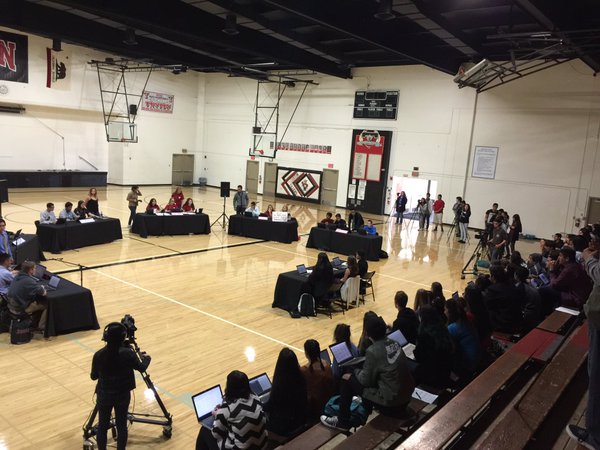
by Gwynn Van Houten
The air is heavy with tension. Everyone feels it: the men and women on the dais, prepared to battle for the favor of the people, and whose words may very well decide the outcome of their futures. In the audience, journalists’ fingers twitch in anticipation, eager to record those words for mass consumption — and scrutinization. Camera crews make adjustments to ensure that the countenance of each candidate is perfectly captured and that the experience is realized by those watching on their screens.
A moderator passes a reporter a microphone so she can — hopefully — pry out some vital knowledge about a particular candidate’s platform.
“Mr. Trump”, she begins, and the audience holds their breath in response to the familiar, controversial name. “How do you plan on dealing with immigrants?”
“The wall is absolutely crucial,” The Donald explains, “and Mexico WILL pay for it.” Hooting and booing alike emanate from the crowd.
The primary proceeds in this fashion, with questions coming from the press and the dais. The six candidates — Trump, Cruz, Rubio, Kasich, Clinton, and Sanders — verbally clash on divisive national issues from abortion, police brutality, immigration, and being offensive. At times the debate gets heated, and voices raise in passion before moderators are forced to sternly intervene. Certain responses cue fervent applause and cheering from the audience, and others incite fury as beliefs and propositions are challenged.
It’s an exciting two-day event, and all parties who contributed put in the effort to make it a memorable part of the presidential race.
This primary is different, though. You wouldn’t be able to tell from just reading their spot-on answers, but these aren’t the real candidates. This was a simulation orchestrated by Tustin High students.
Together, Mr. Johnson’s MUN III class, Mr. Zamora’s Film team, and Mrs. Robinson’s Journalism crew put this together to get a taste of what a news network responsible for covering a presidential debate goes through, and to learn by delving into each real-life candidate’s principles.
Despite having only minimal time to prepare for the debate, MUN students portrayed each candidate accurately and outstandingly. Unlike the actual primaries, they were assisted by a team of three advisors on the dais, but were all individually spectacular: Dacey Zimmerman’s Trump was impressively convincing, especially when going off on a tangent about his plans to build a wall along the Mexican border and end illegal immigration. Keely White captured Hillary Clinton’s noble presence, resolute in her views on women’s rights and other progressive issues. Arsal Bokhari also flawlessly represented Bernie Sanders’s passion for social equality. Cameron Cunningham matched Ted Cruz’s love of traditional, conservative American values. While taking on the role of a relatively unfamiliar candidate, Steven Medina managed to express John Kasich’s quiet conviction, reminding us that he is still a determined Republican candidate. And, while the Floridan senator recently dropped out of the race, Isaac Cinco played an ardent and idealistic Marco Rubio.
And, of course, Lupita Rivera, Chaise Moore, and Angelica Verde all executed their roles as moderators fabulously. Without them, the debate would have turned to chaos.
The experience was enlightening and educational for the students involved. When the views of the actual candidates are emulated, future voters become more engaged in politics and can make more informed decisions. This is especially important for high schoolers, who are not far off from being able to contribute to decisions that will decide the country’s place in the world. Many seniors, in fact, will be able to vote in this year’s election.
As they say, young people are the future, so programs such as this one have the potential to change it.